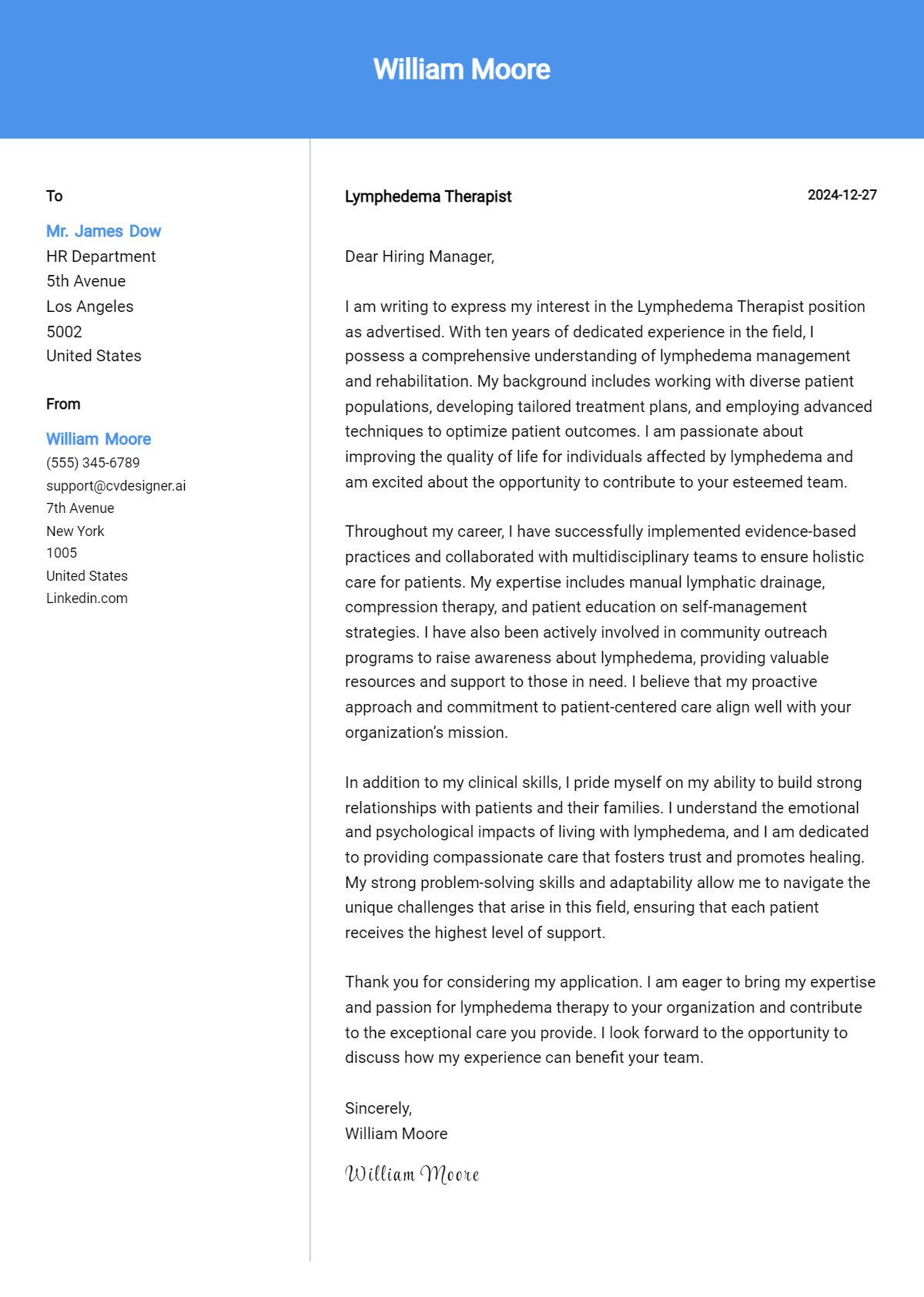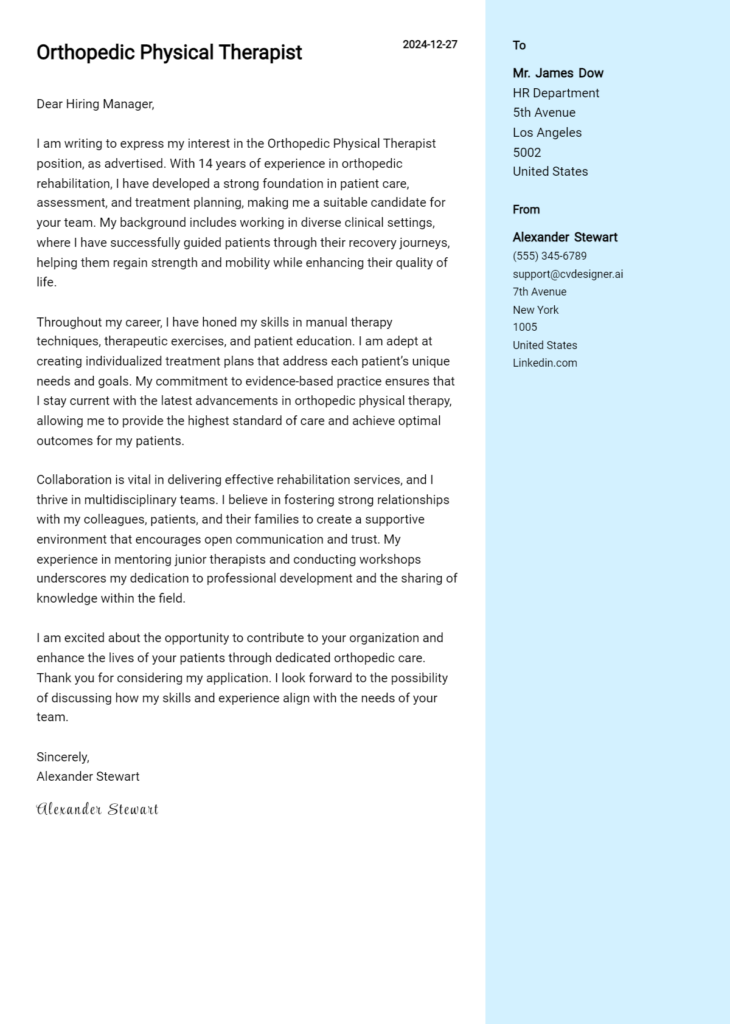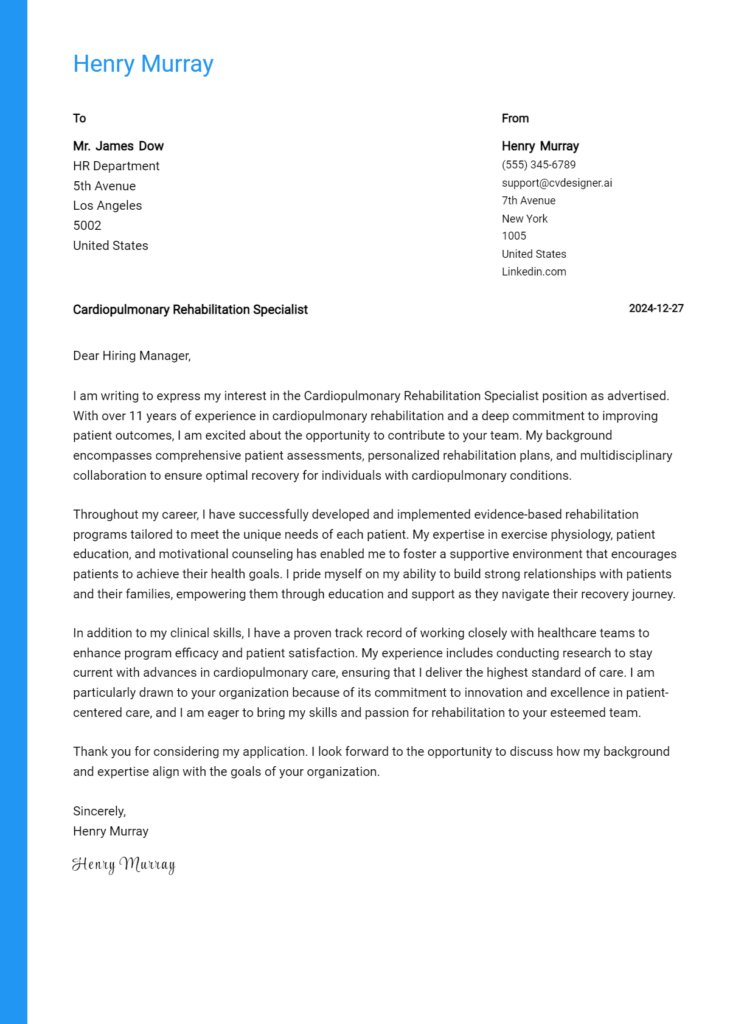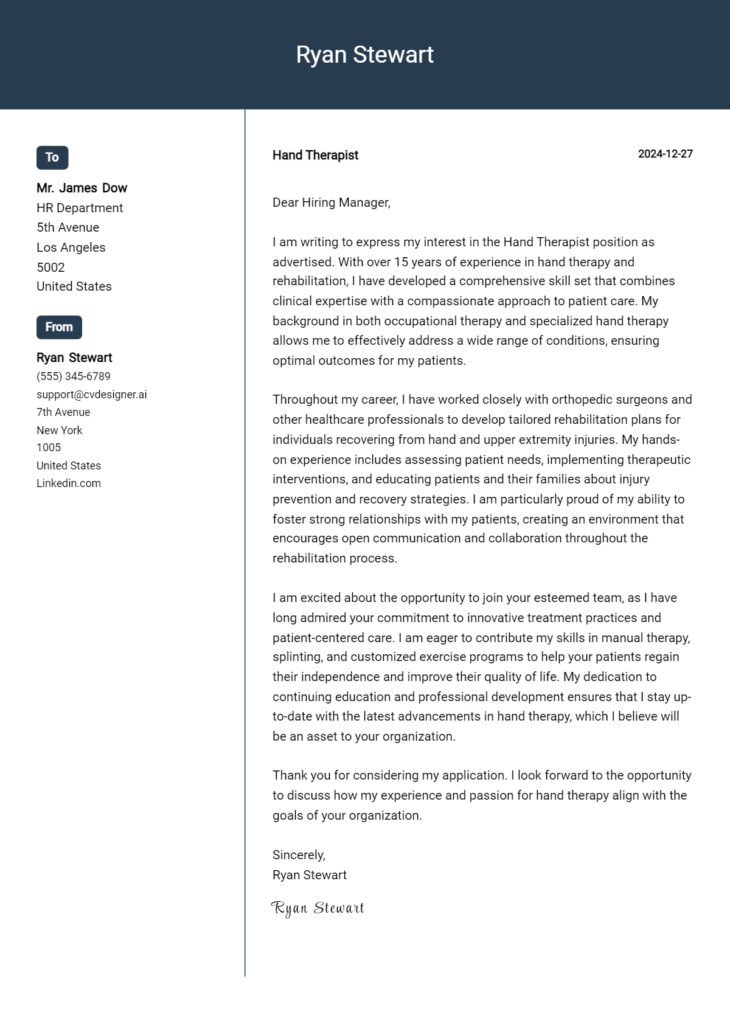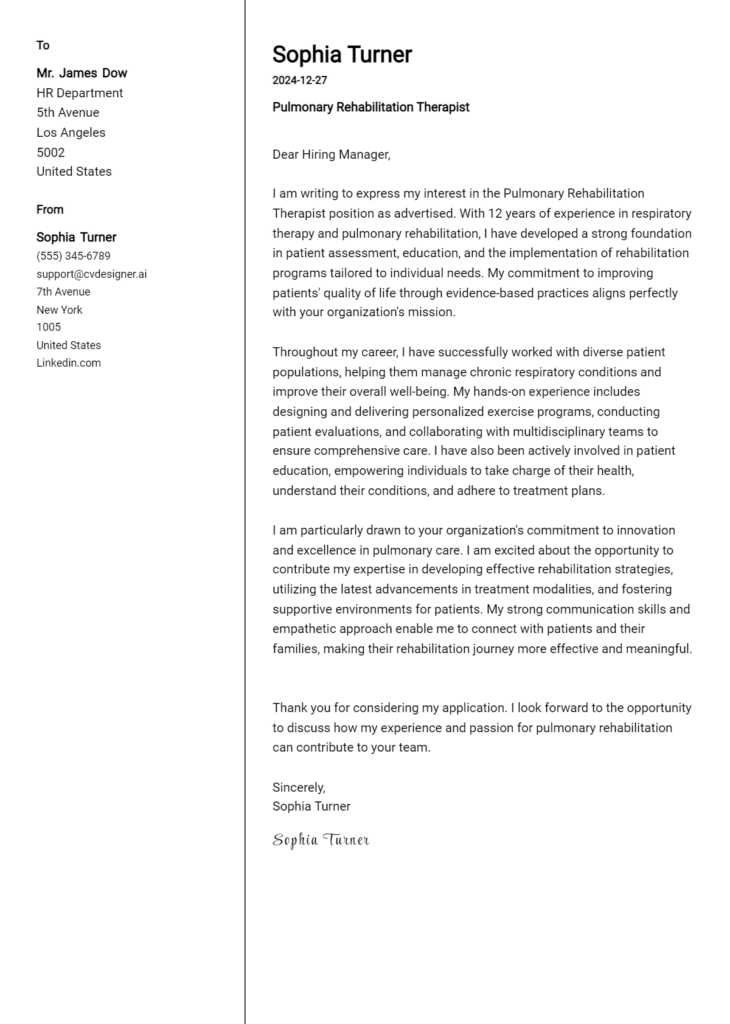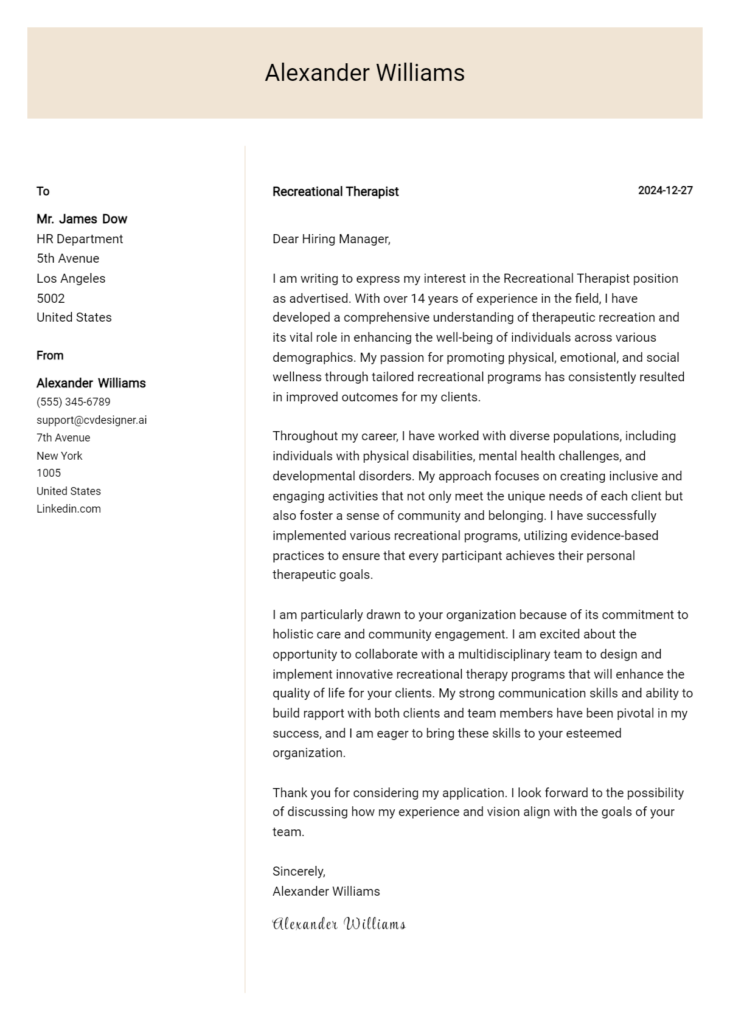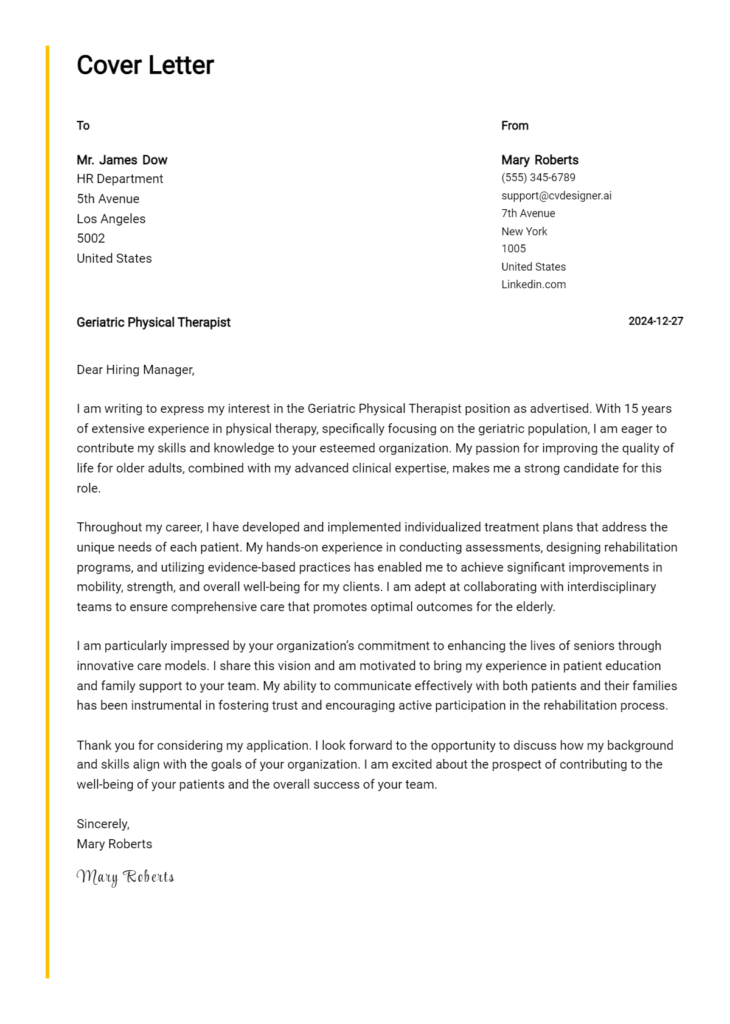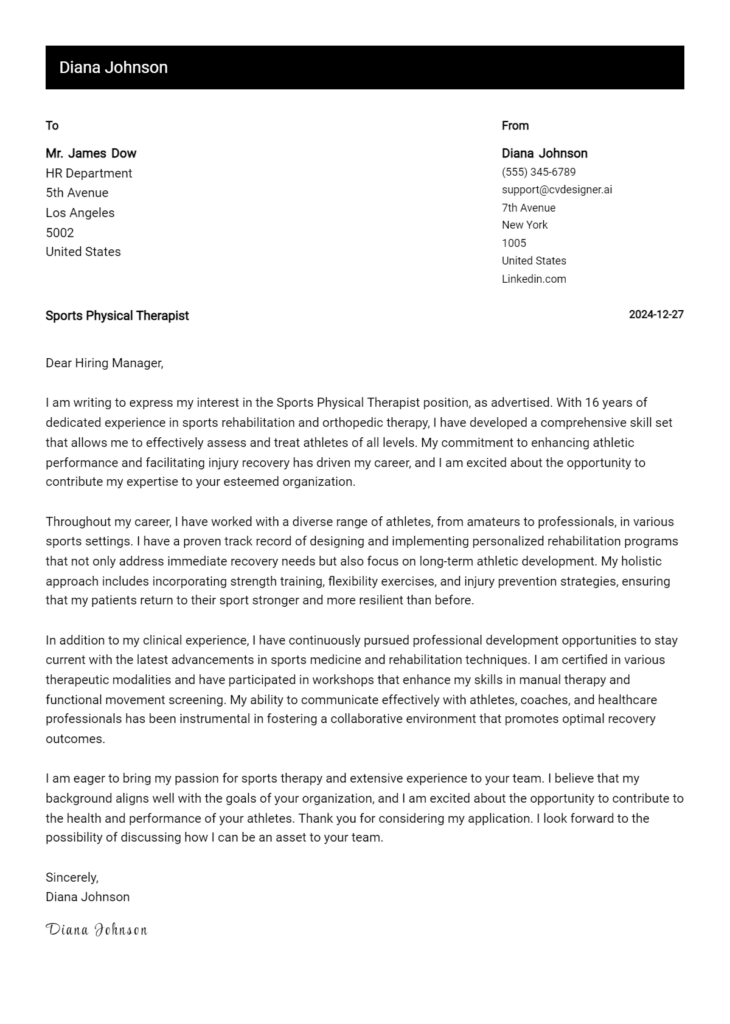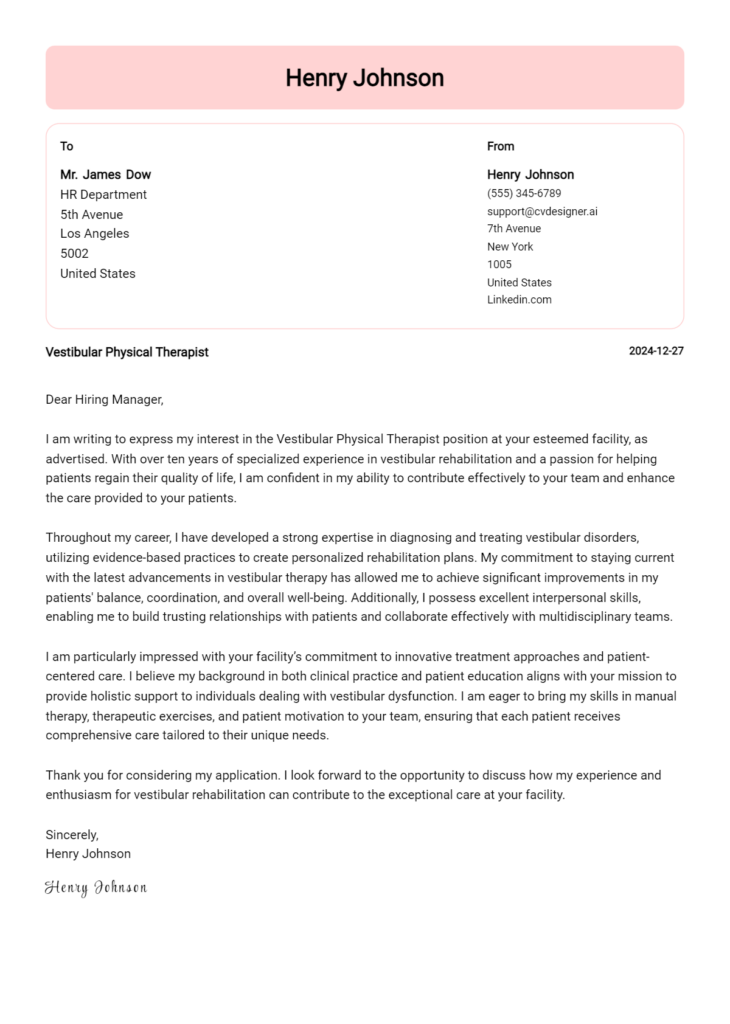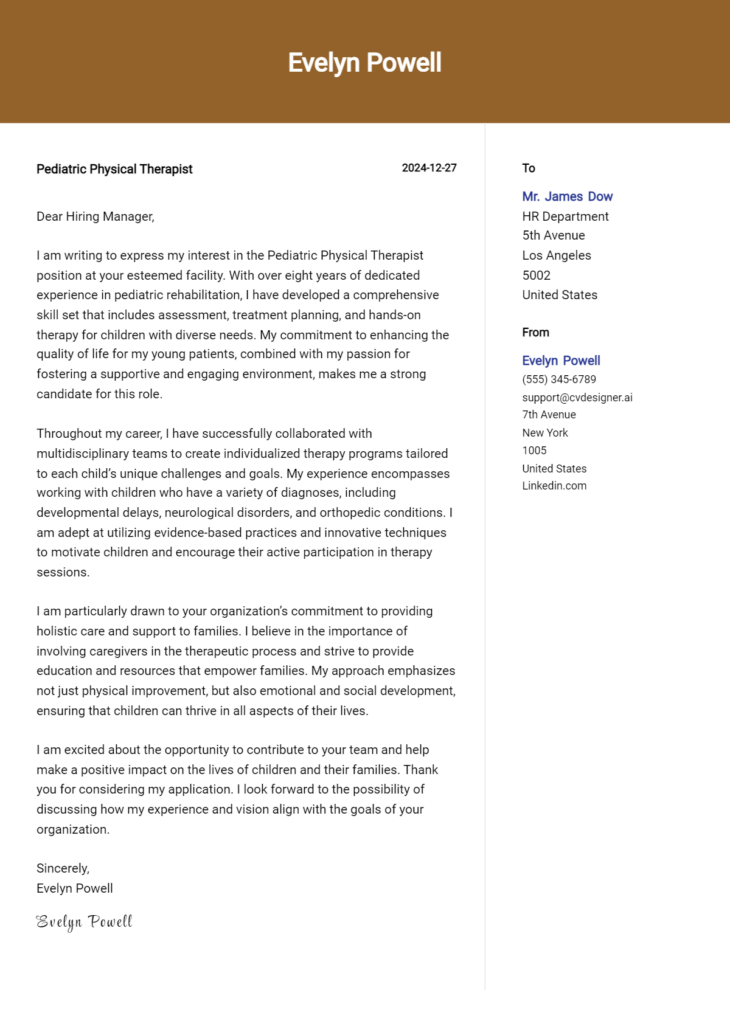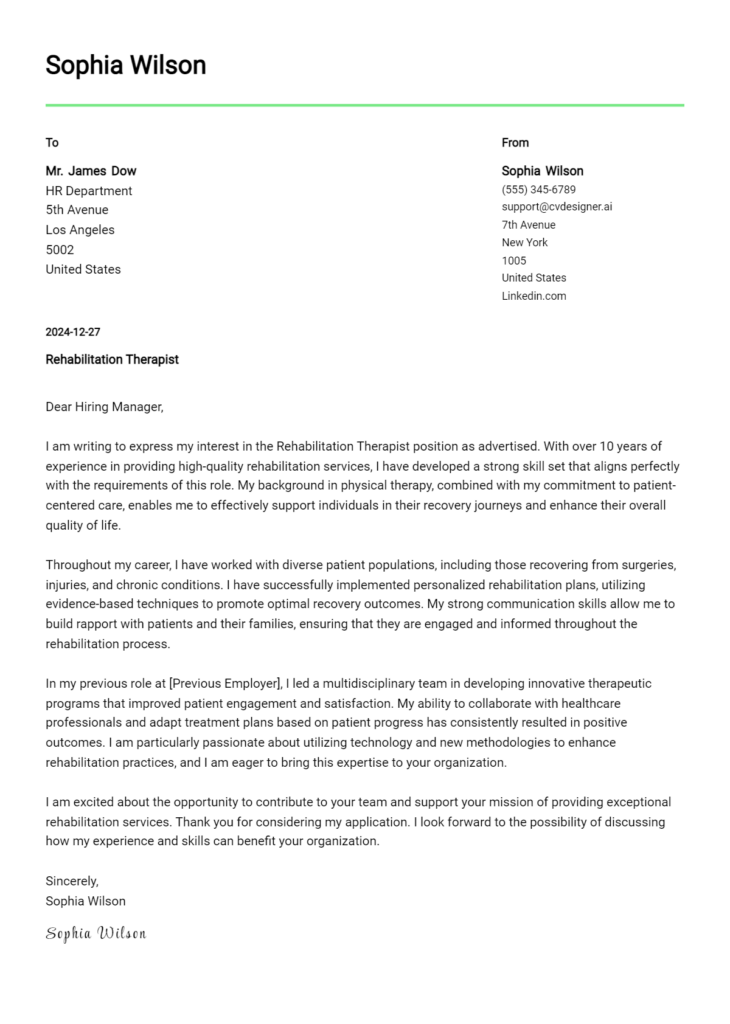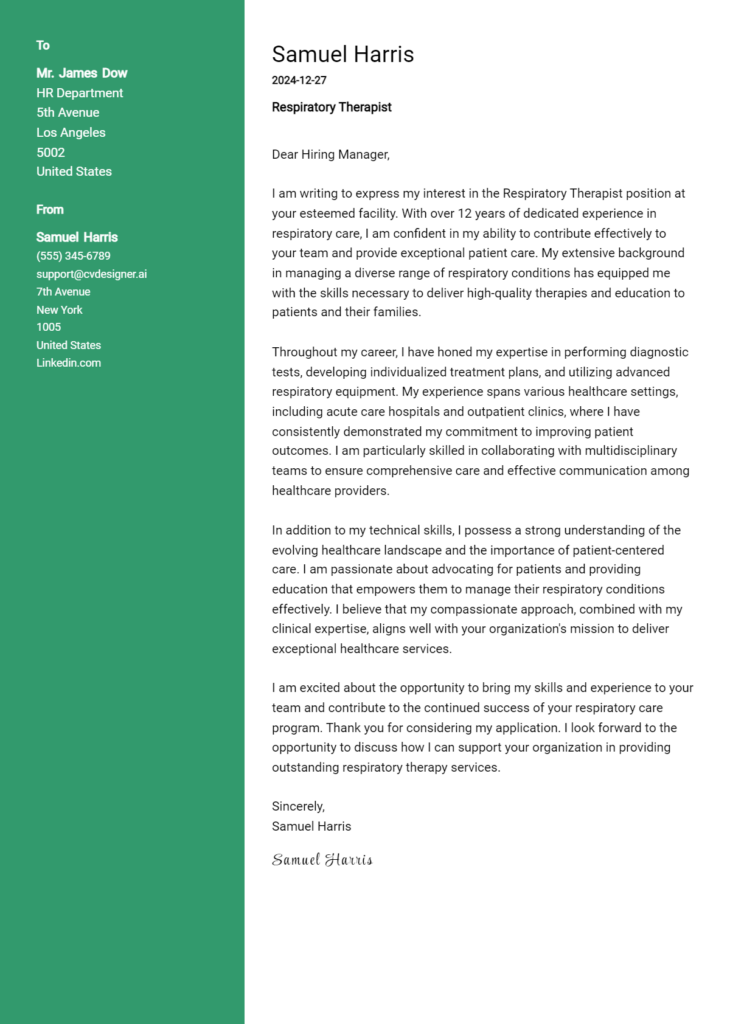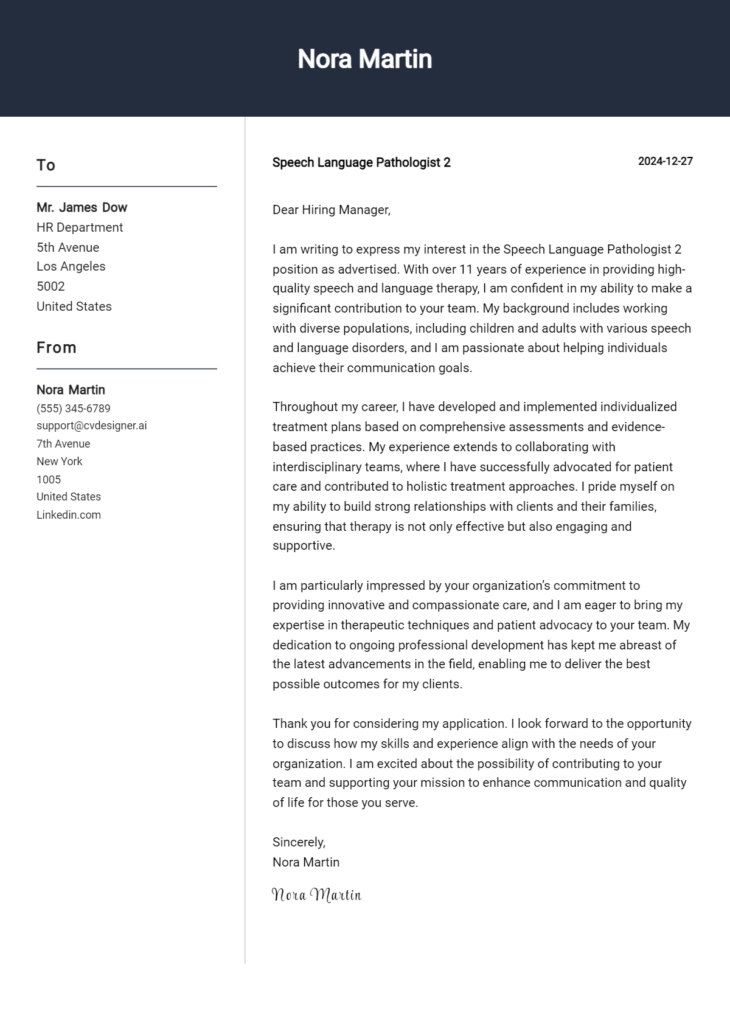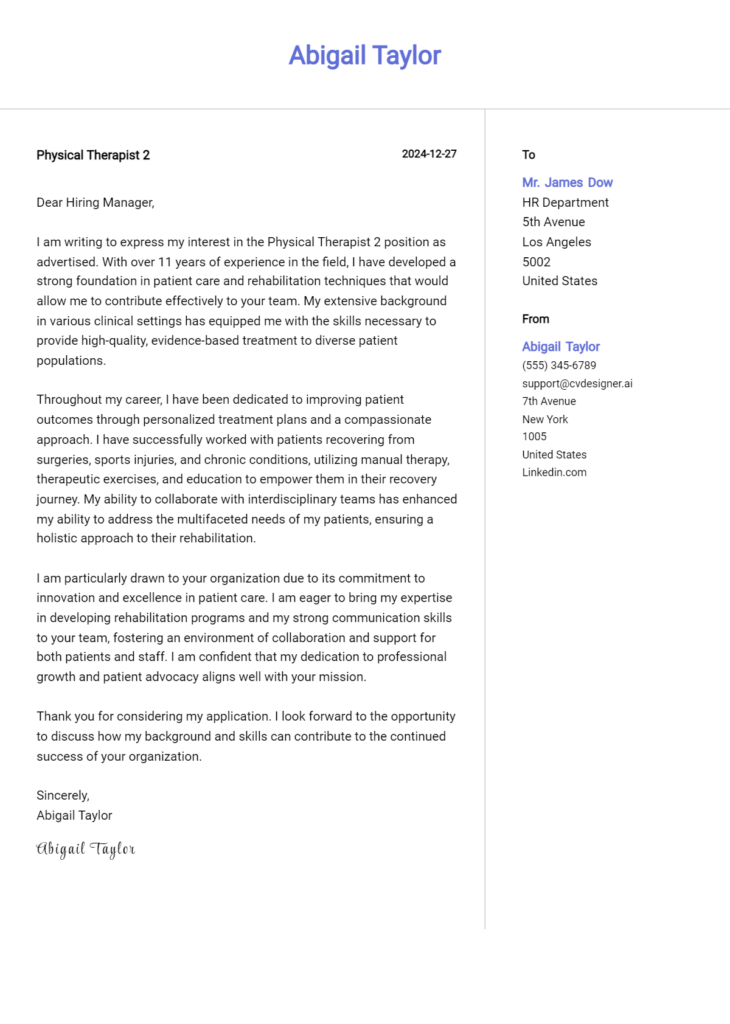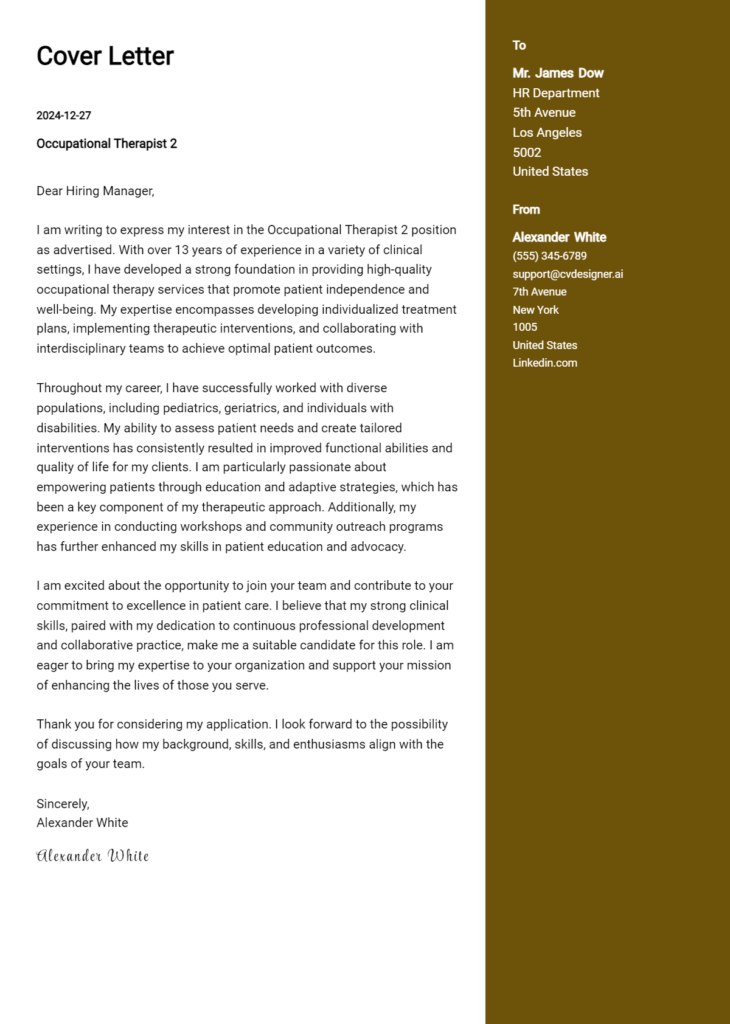Lymphedema Therapist Cover Letter Examples
Explore additional Lymphedema Therapist cover letter samples and guides and see what works for your level of experience or role.
How to Format a Lymphedema Therapist Cover Letter?
Crafting a compelling cover letter is essential for a Lymphedema Therapist, as it not only highlights your clinical skills but also demonstrates your empathy and understanding of patient care. The format of your cover letter serves as a reflection of your professionalism and attention to detail—qualities that are critical in a therapeutic setting. A well-structured cover letter captures the hiring manager's interest and sets the tone for your application, showcasing your commitment to helping patients manage their lymphedema effectively.
In this guide, we'll outline how to structure your cover letter, providing insights and specific examples tailored to the field of lymphedema therapy.
We'll focus on the essential components of a professional cover letter, including:
- Cover Letter Header
- Cover Letter Greeting
- Cover Letter Introduction
- Cover Letter Body
- Cover Letter Closing
Each section is vital in presenting your qualifications and dedication to patient care. Let’s break down each part to help you create a standout cover letter for your role as a Lymphedema Therapist.
Importance of the Cover Letter Header for a Lymphedema Therapist
The cover letter header is a critical component of your application as a Lymphedema Therapist, as it sets the tone for your professionalism and attention to detail. A well-structured header provides essential information at a glance, including your contact details, the date, and the recipient's information. This not only ensures clarity but also facilitates communication between you and the hiring manager. A clear and professional header can make a positive first impression, which is vital in a field that requires compassion and meticulous care.
Below are examples demonstrating the differences between a strong and weak cover letter header for a Lymphedema Therapist:
Strong Example
Jane Doe, CLT-LANA 123 Wellness Way Therapy Town, ST 12345 (123) 456-7890 jane.doe@email.com October 1, 2023 Mr. John Smith Hiring Manager Healing Touch Therapy Clinic 456 Care Avenue Therapy Town, ST 12345
Weak Example
Jane D 1234 Therapy Town Today To Whom It May Concern,
In the strong example, all relevant information is clearly presented and formatted, while the weak example lacks essential details and professionalism.
The Importance of the Cover Letter Greeting
The greeting of a cover letter is crucial as it sets the tone for the rest of the document, establishing a professional yet personalized connection with the reader. A well-crafted greeting demonstrates your attention to detail and genuine interest in the position, indicating that you have taken the time to research the company and its team. Addressing the hiring manager directly, when possible, not only adds a personal touch but also shows your initiative in making a meaningful first impression. To avoid generic greetings that can make your application feel impersonal, it's advisable to invest time in finding out the recipient's name through the company website or professional networking platforms. This small effort can significantly enhance the effectiveness of your cover letter.
Strong and Weak Greeting Examples
Strong Example
Dear Ms. Johnson, I am writing to express my enthusiasm for the Lymphedema Therapist position at Healing Touch Therapy, as advertised on your website.
Weak Example
To Whom It May Concern, I would like to apply for the Lymphedema Therapist job you have posted.
The Importance of a Strong Cover Letter Introduction for a Lymphedema Therapist
A well-crafted cover letter introduction is crucial for a Lymphedema Therapist as it sets the tone for the entire application. This introductory paragraph must capture the hiring manager's attention immediately, expressing genuine interest in the role while succinctly showcasing relevant skills and achievements. A compelling introduction not only highlights the candidate’s qualifications but also demonstrates their passion for helping individuals manage lymphedema effectively. Below are examples of strong and weak cover letter introductions that illustrate the impact of a well-written opening.
Strong Example
Dear [Hiring Manager's Name], As a dedicated Lymphedema Therapist with over five years of experience in clinical settings, I am excited to apply for the position at [Company Name]. My passion for patient care and my expertise in advanced treatment techniques have empowered countless individuals to regain mobility and improve their quality of life. I am eager to bring my skills in personalized treatment plans and patient education to your esteemed team, contributing to the outstanding care you provide.
Weak Example
To Whom It May Concern, I am writing to apply for the Lymphedema Therapist position. I have some experience in this field and think I would be a decent fit. I have worked with patients before, and I hope to learn more about lymphedema therapy if given the chance.
Purpose of the Cover Letter Body for a Lymphedema Therapist
The cover letter body for a Lymphedema Therapist serves as a critical opportunity to present the candidate's qualifications, experiences, and unique value proposition to the hiring organization. This section should effectively highlight relevant skills, such as expertise in manual lymphatic drainage, patient education, and customized treatment planning. Furthermore, it is essential to include specific projects or accomplishments that demonstrate the candidate's impact in previous roles, such as successful patient outcomes or innovative treatment programs they have implemented. By doing so, the candidate can provide tangible evidence of their capabilities and how they align with the goals of the organization, ultimately making a compelling case for their hiring.
Strong Example
I am a certified Lymphedema Therapist with over five years of experience in providing comprehensive care to patients suffering from lymphedema. At my previous position with [Company Name], I successfully implemented a new patient education program that increased patient adherence to treatment plans by 30%. Additionally, I collaborated with a multidisciplinary team to develop individualized treatment protocols that improved patient outcomes, evidenced by a significant reduction in swelling and pain levels among my clients. My commitment to continuous learning and my passion for helping patients regain their quality of life make me an ideal candidate for your team.
Weak Example
I have worked in healthcare for a few years and have some experience with lymphedema. I think I would be a good fit for your company because I care about helping patients. I know a bit about lymphedema treatment and have done some training. I believe I can do well in this role and help your patients.
Importance of the Cover Letter Closing for a Lymphedema Therapist
The closing paragraph of a cover letter serves as a critical opportunity to reinforce your qualifications, express genuine enthusiasm for the position, and prompt the hiring manager to take the next steps. A strong closing can leave a lasting impression, encouraging the employer to review your resume and consider you for an interview. Conversely, a weak closing may fail to convey your interest or summarize your key skills effectively, potentially weakening your application.
Strong Example
Thank you for considering my application for the Lymphedema Therapist position. With my extensive training in lymphatic drainage techniques and my passion for patient-centered care, I am excited about the opportunity to contribute to your team. I look forward to discussing how my skills and experiences align with the goals of your organization. Please feel free to review my resume, and I hope to schedule a time to connect further.
Weak Example
I guess that’s it. I hope you look at my resume. Thanks for your time.
Crafting an effective cover letter for a Lymphedema Therapist position requires a blend of technical expertise, problem-solving skills, and a commitment to patient care. As a candidate, it's essential to showcase your knowledge of the lymphedema treatment process, your ability to work collaboratively with healthcare teams, and your dedication to continuous learning. These tips will guide you in highlighting these critical attributes in your cover letter, helping you stand out in a competitive job market. For additional resources, consider exploring cover letter templates or utilizing a cover letter builder for a polished finish.
Tips for Writing a Cover Letter as a Lymphedema Therapist
Highlight Your Technical Skills
Clearly outline your specific skills related to lymphedema therapy, such as manual lymphatic drainage techniques, patient assessment capabilities, and familiarity with compression therapy. Use concrete examples from your previous work experiences to demonstrate your proficiency and how these skills have positively impacted patient outcomes.Showcase Problem-Solving Abilities
Lymphedema therapy often involves complex cases that require innovative solutions. Share instances where you successfully addressed challenging patient needs or developed tailored treatment plans. This will illustrate your critical thinking skills and your ability to adapt to various situations, which is vital in this field.Emphasize Knowledge of the SDLC
Understanding the Software Development Life Cycle (SDLC) can be an asset, especially if you have experience with electronic health records or telehealth systems. Mention any relevant training or projects where you contributed to the development or implementation of technology that improves patient care, showcasing your ability to integrate tech solutions in your practice.Demonstrate Teamwork and Collaboration
Lymphedema therapy often involves working with a multidisciplinary team. Highlight your experience collaborating with doctors, nurses, and other therapists to provide comprehensive care. Use examples that showcase your ability to communicate effectively and contribute to a positive team dynamic, emphasizing your role in achieving shared patient goals.Express a Passion for Continuous Learning
The medical field is always evolving, and as a Lymphedema Therapist, it’s crucial to stay updated with the latest research and techniques. Discuss any relevant certifications, workshops, or ongoing education that you are pursuing to enhance your skills. This will convey your dedication to personal and professional growth, which is attractive to potential employers.
Common Mistakes to Avoid in a Lymphedema Therapist Cover Letter
Crafting a compelling cover letter is essential for standing out in the competitive field of lymphedema therapy. Avoiding common mistakes can significantly enhance your chances of landing an interview. Here are several pitfalls to steer clear of:
Generic Greetings: Using a vague salutation like "To Whom It May Concern" can come off as impersonal. Instead, try to find the hiring manager's name for a more personalized touch.
Lack of Specificity: Failing to mention specific skills or experiences relevant to lymphedema therapy can weaken your application. Highlight your qualifications and demonstrate how they align with the job requirements.
Lengthy Paragraphs: Long, dense paragraphs can be overwhelming. Aim for concise, well-structured content that is easy to read. Break up text with bullet points if necessary.
Ignoring the Job Description: Not addressing the specific qualifications listed in the job description can signal a lack of interest or attention to detail. Tailor your content to reflect the key qualifications and responsibilities mentioned.
Overlooking Professional Formatting: A poorly formatted cover letter can detract from your professionalism. Refer to cover letter format for tips on structuring your letter effectively.
Neglecting Proofreading: Spelling and grammatical errors can undermine your credibility. Always proofread your letter or ask a colleague to review it before submission.
Failure to Convey Passion: Not expressing genuine enthusiasm for the role can leave a negative impression. Use your cover letter to convey your passion for lymphedema therapy and your commitment to patient care.
By being mindful of these common mistakes and implementing the suggested strategies, you can create a persuasive cover letter that increases your chances of success. For inspiration, check out these cover letter examples to see how others have successfully navigated this important step in the job application process.
Cover Letter FAQs for Lymphedema Therapist
What should I include in my cover letter as a Lymphedema Therapist?
Your cover letter should highlight your relevant qualifications, experience, and passion for lymphedema treatment. Start with a strong introduction that states the position you’re applying for and how you found it. Include specific details about your education, such as any certifications in lymphedema management or related therapies. Discuss your clinical experience, emphasizing your skills in patient assessment, treatment planning, and education. Don’t forget to mention any specialized training or workshops you’ve attended. Finally, express your enthusiasm for the opportunity to contribute to patient care and the mission of the facility, demonstrating your alignment with their values.
How can I demonstrate my experience effectively in the cover letter?
To effectively demonstrate your experience, use specific examples that illustrate your skills and achievements. Instead of general statements, describe situations where you successfully managed patients with lymphedema, including the techniques and therapies you employed. Quantify your accomplishments when possible, such as the number of patients treated or improvement metrics observed. Highlight any multidisciplinary collaboration with other healthcare professionals, showcasing your ability to work as part of a team. Use action verbs and concise language to make your experiences stand out, while ensuring that it aligns with the job description to show relevance to the position.
Should I tailor my cover letter for each application?
Yes, tailoring your cover letter for each application is vital. This shows prospective employers that you have a genuine interest in their specific position and organization. Research the facility’s values, culture, and patient demographics to better understand how your skills and experiences align with their needs. Customize your cover letter by incorporating keywords from the job listing and mentioning specific programs or initiatives the organization is known for. This personalized approach not only demonstrates your enthusiasm but also increases the likelihood that your application will catch the eye of hiring managers.
How long should my cover letter be?
Your cover letter should ideally be one page long, consisting of three to four paragraphs. Aim for a concise and focused document that communicates your qualifications without overwhelming the reader. Each paragraph should serve a specific purpose: an introduction stating your intent, a body section detailing your relevant experience and skills, and a conclusion expressing your enthusiasm for the role and a call to action. Keep your writing clear and professional, using an appropriate font size and spacing to ensure readability. A well-structured, succinct cover letter will make a stronger impact than a lengthy one.
Build your Cover Letter in minutes
Use an AI-powered cover letter builder and have your letter done in 5 minutes. Just select your template and our software will guide you through the process.

